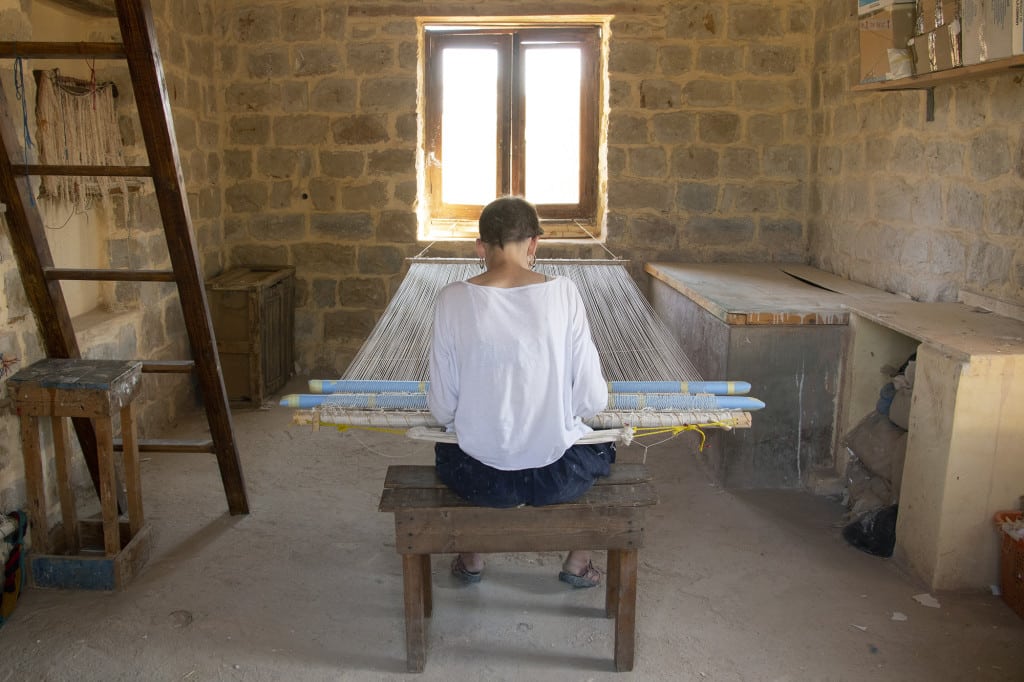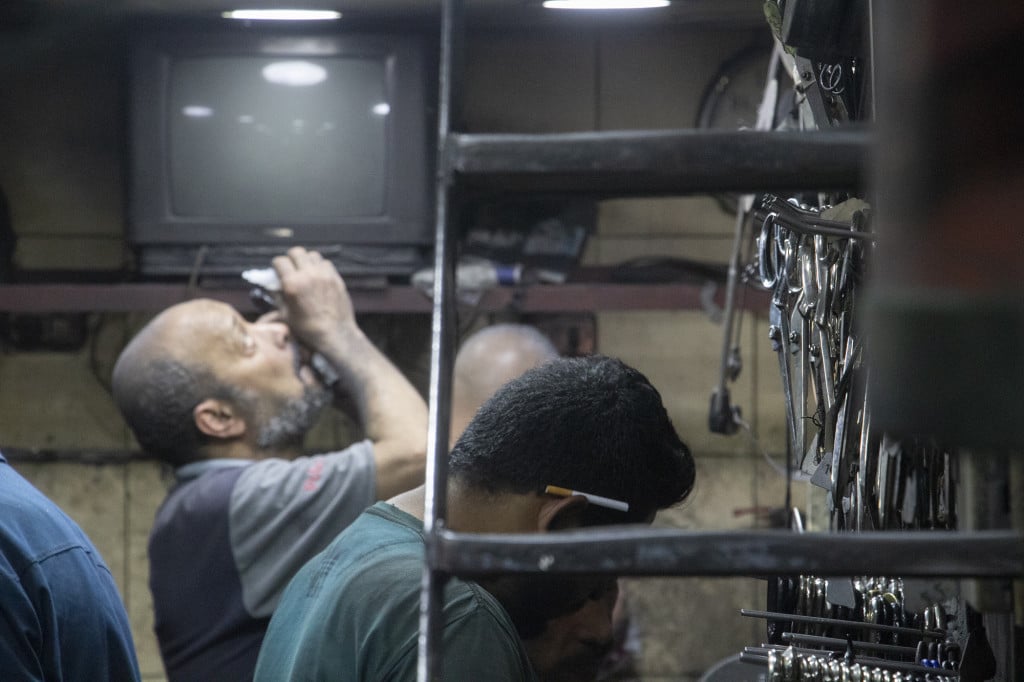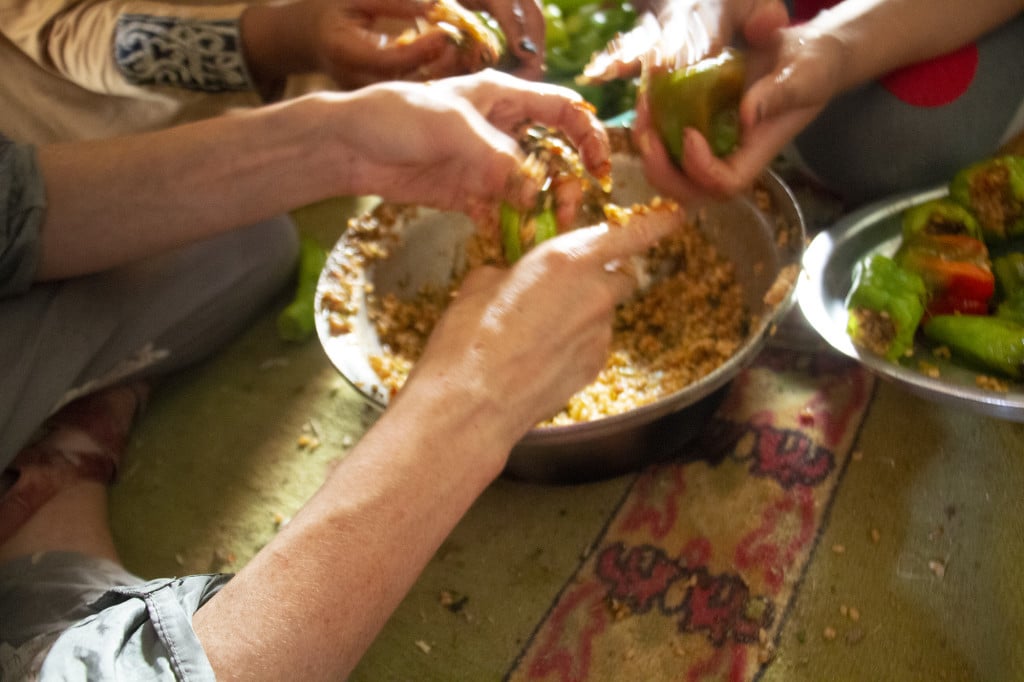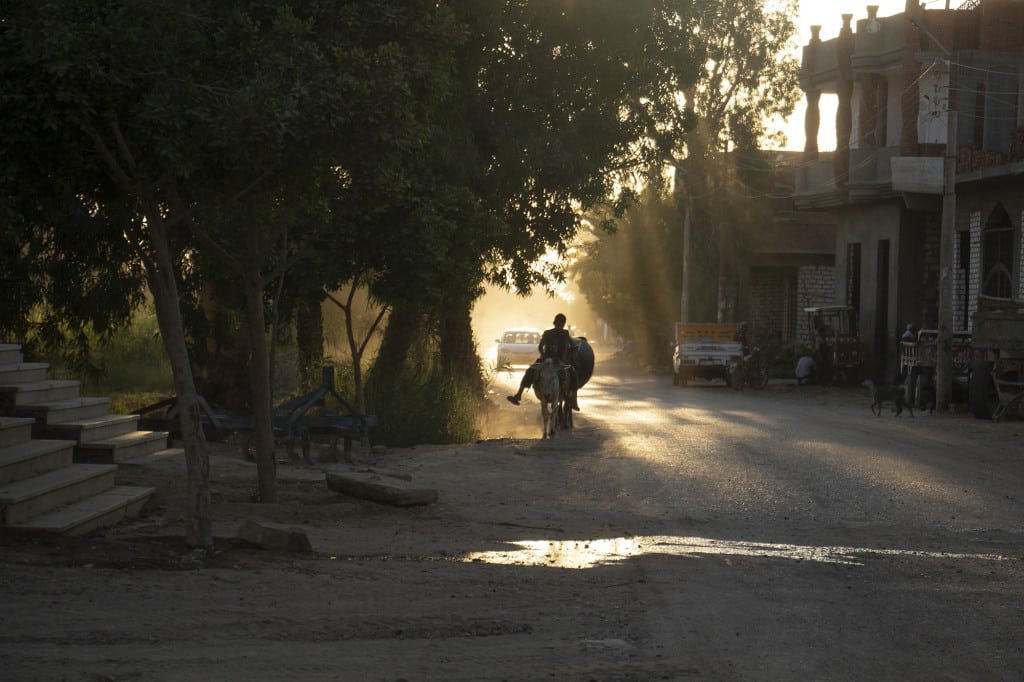I do feel like my time so far in Egypt is divided in to sections because I’ve been learning so much. I remember sections of time because they all had different feelings. In the first few weeks I was really high on everything. I would just watch really simple things for ages. I remember my first walk in to the village when a boy came past on his donkey. It was about six in the evening and getting dark. The boy was really little, about five, and it felt really exceptional at the time that a boy would be on his own on a donkey. Now I wouldn’t bat an eyelid. And he had a mobile phone and was watching a video. He looked like a little boy whose mum had parked him in front of an iPad while she made dinner, or something, but he was on a donkey coming back from a field.
The next section of time I remember clearly is January and February, and the Winter Academy, a six-week art school for artists from Egypt and abroad that suddenly filled the Art Centre with people. It would be really busy and there’d be 20 people each morning at breakfast. For most of it I was busy preparing my course. I taught a week-long workshop on how to make sculpture out of paper.
There are also the times when I’m in Cairo. I go to Cairo for material research and to meet people. I’m probably there about four days per month and it feels very different. I always feel a bit nervous before I go there. It’s only two hours down the road but it’s a different time zone, you know. El Attaba is an incredible part of Cairo, especially for a sculptor. It’s a big region in the centre with hundreds of workshops and shops. Basically, you can buy anything there. And because there are workshops as well as shops you can see things being made and destroyed all the time.
Ramadan is another specific period with its own type of routine, or atmosphere, for daily life. I sort of loved Ramadan. It started on the 7th of May, I think, when the weather was changing and it was getting increasingly hot. By Eid it was really hot. It changes the rhythm of the day and how people act, how people move and talk to each other. I decided to fast. I knew almost everyone in the village would fast and I wanted to understand it personally, and for the simplicity of it.
The continuities across these eight months are, well, I’ve told you about going on regular trips to Cairo for materials. And of course, I spend most of my time in the studio, gradually seeing my sculptures develop. But the other thing is that very early, within my first few days in the Art Centre, I started going for a walk in the village. Not every day but most. My relationship with the village has been very important because the Art Centre, I suppose like many residency centres in rural places, has a separation from the village, from its environment. It’s a bit of a bubble. Going for a walk and talking to people every day makes me feel at home and it’s helped with my Arabic. It has been a really important continuity. It suits me really well because I usually do my social thing in the morning. I go and walk and talk to people and then go back to the studio and work all day.
Since the Spring, Georgina has been writing us letters.
Dear Pangaea,
Today is the last day of March. It’s Friday, Goma, when most people aren’t at work, but go to mosque and see their families. This morning I was going to buy groceries when a family I hadn’t met before invited me to breakfast. I met four men and five women, five children and a four day old baby. This is how families live in Tunis. While even in Cairo it’s common for people of any class to live with their families until they marry, here it would be really very strange to do anything else. After marriage it’s ideal to move to another bit of the family home, (which means that houses are being extended upwards all over the village).
I have two married sisters. It’s impossible to know how we’d be if we lived like that, but I know we’d have different personalities and I’d make different art. Because these personal arrangements affect how we think and that affects the character of work, including artistic work.
In a close, full home (and in a village and a country full of such homes), the secure condition of being known is the normal condition of life. Being a part of your family seems to be the centre of life. People work really hard of course, in the fields and houses and workshops, and sometimes they work with speed and urgency, but the reason seems practical and temporary, not frenetically internal.
Whereas I think that in London, Malmo and Berlin, (where I lived before here), individual effort is the engine of a lot of people’s lives, with alone-ness and urgency being normal accompanying internal conditions. Imagining the sculptors I know, I think of us all powering along, driven by our own engines of effort: moving heavy stuff around a sequence of hard to afford and impermanent studios, fitting artwork around money-work while trying to stay connected to dear but often distant, mutually near-neglectful friends.
I am a lone ‘one’, and I make things. They relate to my body, I make them fit me: my eyeline, my armspan. They need a huge amount of my time and energy to reach stable existence, and even then, they tend to have a tense, precarious quality as a result of being contingently engineered in response to their unpredictable materials. Our ‘relationship’ is very close and I think about them a lot. They are my ‘main thing’ (apart from my family and dear friends, but I see them much more than I see those people). All those sentences are still true. But here that relationship has begun to lose its clinging frenetic-ness. It is enough to do the work that needs to be done. That way of thinking is changing the work itself. I look forward to seeing how.
More soon.
Georgie
Dear Pangaea,
It’s mid April. Ramadan will start soon and it’s getting hot. My work is progressing slowly but steadily: the only way that seems right or possible. It’s hard to schedule or compress the explorative processes my work involves. Also, I need time and thought to pay attention to the way life is going on around me. I find everyday things continually interesting: how boys in the village watch videos on their phone while riding their donkey, how farmers determine the flow of water through the village by building dams in the irrigation ditches, how men and women negotiate personal space in the village’s one busy shop. They’re little clues about bigger things: inventiveness, geography, power.
Every conversation is a puzzle. People are almost always kind and patient, it’s my effort level which fluctuates. Being a subject of curiosity can easily take more time and energy than it’s wise to give. Wonderfully, I’m just beginning to ‘know’ some people well enough that our talks are less chipper and light and more-even tempered and interesting.
Ingy, for example. She’s twelve. Her mum fries fish on the roadside outside their house: my first Tunis meal, and first Tunis friends. After weeks of invitations she came to see my studio. (The Art Centre is close to the village, but it feels separate. Its visitors come from Cairo, Alexandria or abroad, not the village.) Demonstrating gestures and our sparse shared vocabulary were all that was needed for Ingy to understand the physical logic behind my sculptures’ strange shapes. She said she wanted to make things too. We began with ‘Horson’, (a horse), making a wire skeleton covered with masking tape as a base for papier mâché. By then it was getting dark so she went home, taking Horson, a brush, glue and paper. I think my sculptures are the only papier mâché things she’s seen because Horson ended up covered in spikey little scrumples like the ones I’m using, not the flat pieces anyone who covered a balloon in primary school would think to use.
Ingy’s school doesn’t do art. One day I agreed to help her and some friends with their English homework. They were giggly and silly. I got frustrated. She told me they get hit in class, and gave me a stick. I’m beginning to understand violence better than I have before. Its presence here is very noticeable. A few evenings ago at dinner, Ingy and her mum told me how a mutual friend has left her husband because of how much he hits her.
Quite often unexpected things – a chance conversation, the birth of kittens on my studio floor – changes the course of my days. The other day I was hurrying to get a new big needle from the mattress-maker, (a very skilled and friendly man who can’t hear or speak). I met some children who often play along beside me as I walk down their street. This time, they insisted I went to see their mother. She had a scrap of paper with a phone number she wanted me to ring. (She can’t read, and doesn’t seem to have a phone.) Minutes went by without her getting through. She did eventually and spoke for a bit, trying to persuade the person of something, I think. Obviously sad, she tore the paper into bits and dropped them on the floor. She swept them up again and put them in the bin, and then just kept on sweeping even though the floor was clean. I said I was sorry and left.
The scene is lingering in my mind, in my studio. But my work there needs clear minded attention. It also needs a huge amount of time. I didn’t plan to, but I’ve been doing an experiment: Can I work how I need to, to make what I need to, while being more willingly absorbed in the world? I can’t judge the results yet, I’m still setting it all up.
More soon.
Georgie
Dear Pangaea,
Today is the sixteenth day of Ramadan. It is incredibly hot. After weeks spent working out how to weave my carpet I’ve come back to my sculptures. They’re still months of steady work away from completion but they’re becoming very interesting things to make.
I started out with a series of stiff cymbal-like discs of different diameters. Since then I’ve been adding layers or gluey paper scrumples to the top and bottom surface of each cymbal. I’ll carry on until its form fills the capacity of my hugging arms and I can only just touch my fingers together at the far side of the disk.
A brilliant thing happened when I put on the first top and bottom layer after I arrived in November. The wet weight caused the larger discs to sag along one axis, so they became saddle shaped. (To different extents: there’s a relationship between disc thickness, surface area and wet weight that I’d need more increments to figure out.) Suddenly the plan to add mass to the point of finger-tip-touch rotundness became a new proposition, as the flat disk became a contour of highs and lows. How now to fill the space ‘allowed’ by my arms at the highest points, but still be able to touch the disk where it dips low? I realised the only logical answer is to fill the spare space outwards not upwards. Imagine two dumpy cones, the bottom one upside down, with a disk snuggled between them. Where each one meets the disk it swells, mushroom-top like, beyond the edge but only along one axis, opposite that of the other cone’s protrusions. Or at least, that’s what seems to be happening. Each form is slowly revealing its own character. It will become every more sun-bleached. I’m hoping for an acrid urine yellow.
They’re going to be strange! But the strangeness will have come from the interaction of volumes and lengths, light and paper: there’s nothing emotional about it. For months last year I had in mind the collective title The Embraces. Maybe that name will stick, but my embraces are practical and methodical. The sculptures are what they are. I can’t find personifying adjectives to pin on them.
When they’re done I’ll take them to the desert and make drawings and photos. I think they’ll sit well within its steady quiet ancientness. It has no smell and not much noise. Air moves about, light comes and goes. The sculptures will wobble a bit on their stands, and their paper will get yellower….
How will they look? I’ve got to know two ‘bits’ of the desert: the massive landscape you see from a 4×4 on the way to the archeological sites and lakes near Tunis, and the un-gasped-at empty land you commute through to get to Cairo. They’re populated by different forms: the first has beautifully strange wind-carved rock formations, the second abandoned food carts and road signs. I’ve looked at both species a lot. My things won’t be as beautiful, or as familiar: they’ll be something else again.
More soon,
Georgie
Dear Pangaea,
Today is the first of June. Eid is almost here. The sheep bought for the Eid feast just escaped so I write this in my studio, tired from the chase and smelling like sheep. I’ve been here almost seven months. The days I remember most clearly have been spent learning about materials and techniques I am keen to use from people who understand them completely.
The potters of the nearby village of Nazla, for example. Their way of making near-spherical vessels by moulding river clay against the walls of rounded holes in the ground has hardly changed since the time of the Pharoahs. They sit with a crossed-legged, arm-filled closeness to the pot which oddly parallels how I’m making my paper things. The first time I went to see them I could speak just enough Arabic to explain my interest. I’d bought my portfolio and some little sculptures. We talked about the connections between our work and how I should use their clay.
At first things felt tense: children were holding out their hands for money but I didn’t have any change. Nazla is too far from Cairo to get many tourists and the big simple vessels aren’t natural ‘impulse buys’, so I imagine the unprofitable anthropological curiosity of ‘adventurous types’ like me must be frustrating. What changed to allow the proper conversation that followed? Was it me speaking a bit of Arabic, or being keen to go down a sooty tunnel to see the kiln, or showing my work, or being prepared to spend some money? It was a mixture. I recognise and love the patient, generous mood of such ‘material conversations’ which happen between makers when disparities (of privilege, education, and experience) are temporarily put aside as irrelevant. I wanted to know: did I have to fire the sculptures or was air drying possible? Maybe. It depended. Depended on what? And so we began…
Recently I’ve begun to get to know some women at a carpet weaving workshop near Giza. I’ve spent lovely hours sitting between them at their looms, gradually beginning to understand their work while learning snippets of Arabic and giving quick fire suggestions to the children of things to draw, using up my sketchbook.
But some of the women seem shy or aloof. I’ve found myself getting internally frustrated that they aren’t willing to slow their speech or weaving action down to the snail’s pace I can cope with. But why should they? Maybe over months I’ll speed up and they’ll slow down. I will try, and will wait to see. I already understand more deeply that material conversations won’t work properly, won’t happen at equal eye level, if the artist begins them with a bouncy entitled reliance on their own novelty value. That arrogance doesn’t allow for the complexity or unpredictability of other people’s responses. In Harania I am not a novelty, I am a strange and unexpected presence. I’m often ignored by adults but children are unsettlingly curious. One day a group of children followed me, shouting the same questions again and again. A few of them threw stones. Later that day, after a weird moment of mutual recognition, one of them, (a ‘thrower’, I suspected) joined his sister lying on the rug beside their mum’s loom and drew some lovely snakes in my sketchbook.
More soon,
Georgie



